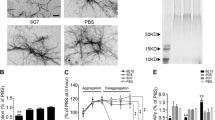Abstract
Amyloid forming molecules are generally considered harmful. In Alzheimer’s Disease two amyloid molecules Aβ A4 and tau vie for consideration as the main pathogenic culprit. But molecules obey the laws of chemistry and defy the way we categorize them as humans with our well-known proclivities to bias in our reasoning. We have been exploring the brains of multiple sclerosis patients to identify molecules that are associated with protection from inflammation and degeneration. In 2001 we noted that aB crystallin (cryab) was the most abundant transcript found in MS lesions, but not in healthy brains. Cryab can reverse paralysis and attenuate inflammation in several models of inflammation including experimental autoimmune encephalomyelitis (EAE), and various models of ischemia. Cryab is an amyloid forming molecule. We have identified a core structure common to many amyloids including amyloid protein Aβ A4, tau, amylin, prion protein, serum amyloid protein P, and cryab. The core hexapeptide structure is highly immune suppressive and can reverse paralysis in EAE when administered systemically. Administration of this amyloid forming hexapeptide quickly lowers inflammatory cytokines in plasma like IL-6 and IL-2. The hexapeptide bind a set of proinflammatory mediators in plasma, including acute phase reactants and complement components. The beneficial properties of amyloid forming hexapeptides provide a potential new therapeutic direction. These experiments indicate that amyloid forming molecules have Janus faces, providing unexpected benefit for neuroinflammatory conditions.
Similar content being viewed by others
References
van Noort JM, van Sechel AC, Bajramovic JJ, el Ouagmiri M, Polman CH, Lassmann H, et al. The small heat-shock protein alpha B-crystallin as candidate autoantigen in multiple sclerosis. Nature. 1995;375(6534):798–801.
Ousman SS, Tomooka BH, Van Noort JM, Wawrousek EF, O’Conner K, Hafler DA, et al. Protective and therapeutic role for aB-crystallin in autoimmune demyelination. Nature. 2007;448:474–9.
Han MH, Hwang S, Roy DB, Lundgren DH, Price JV, Ousman S, et al. Proteomic analysis of active multiple sclerosis lesions reveals therapeutic targets. Nature. 2008;451:1076–81.
Arac A, Brownell SE, Rothbard JB, Chen C, Ko RM, Pereira MP, et al. Systemic augmentation of {alpha}B-crystallin provides therapeutic benefit twelve hours post-stroke onset via immune modulation. Proc Natl Acad Sci U S A. 2011;108(32):13287–92.
Pangratz-Fuehrer S, Kaur K, Ousman SS, Steinman L, Liao YJ. Functional rescue of experimental ischemic optic neuropathy with aB-crystallin. Eye. 2011;25(6):809–17.
Velotta JB, Kimura N, Chang SH, Chung J, Itoh S, Rothbard J, et al. αB-crystallin improves murine cardiac function and attenuates apoptosis in human endothelial cells exposed to ischemia-reperfusion. Ann Thorac Surg. 2011;91(6):1907–13.
Kurnellas MP, Adams CM, Sobel RA, Steinman L, Rothbard JR. Amyloid fibrils composed of hexameric peptides attenuate neuroinflammation. Sci Transl Med. 2013;179:179ra42.
Grant JL, Bou Ghosn EE, Axtell RC, Herges K, Kuipers HF, Woodling NS, et al. Unexpected therapeutic benefit from peripheral administration of amyloid-β in Th1- and Th17-versions of experimental autoimmune encephalomyelitis. Sci Transl Med. 2012;4:145ra105.
Rothbard JB, Kurnellas MP, Brownell S, Adams CM, Su L, Axtell RC, et al. Therapeutic effects of systemic administration of the chaperone alpha B crystallin associated with binding proinflammatory plasma proteins. J Biol Chem. 2012;287(13):9708–21.
Kurnellas MP, Brownell SE, Su L, Malkovskiy AV, Rajadas J, Dolganov G, et al. Chaperone activity of small heat shock proteins underlies therapeutic efficacy in experimental autoimmune encephalomyelitis. J Biol Chem. 2012;287:36423–34.
Tanaka N, Tanaka R, Tokuhara M, Kunugi S, Lee YF, Hamada D. Amyloid fibril formation and chaperone-like activity of peptides from alphaA-crystallin. Biochemistry. 2008;47:2961–7.
Gourdain P, Ballerini C, Nicot AB, Carnaud C. Exacerbation of experimental autoimmune encephalomyelitis in prion protein (PrPc)-null mice: evidence for a critical role of the central nervous system. J Neuroinflammation. 2012;9:25.
Ji Z, Ke ZJ, Geng JG. SAP suppresses the development of experimental autoimmune encephalomyelitis in C57BL/6 mice. Immunol Cell Biol. 2012;90:388–95.
Weinger JG, Davies P, Acker CM, Brosnan CF, Tsiperson V, Bayewitz A, et al. J Neuropathol Exp Neurol. 2012;71(5):422–33.
Author information
Authors and Affiliations
Corresponding author
Rights and permissions
About this article
Cite this article
Steinman, L., Rothbard, J.B. & Kurnellas, M.P. Janus Faces of Amyloid Proteins in Neuroinflammation. J Clin Immunol 34 (Suppl 1), 61–63 (2014). https://doi.org/10.1007/s10875-014-0034-3
Received:
Accepted:
Published:
Issue Date:
DOI: https://doi.org/10.1007/s10875-014-0034-3




